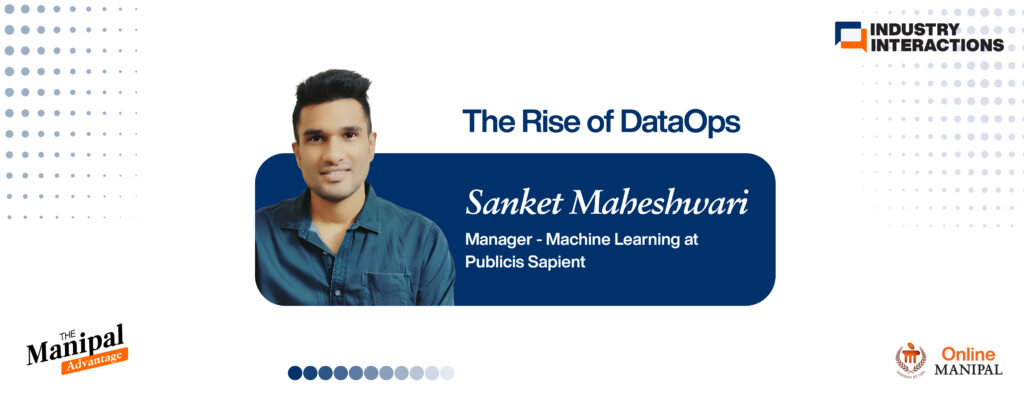My entire professional career has been deeply involved with AI and machine learning. During that period, I have constructed innumerable models, observed the changes in fads, and become convinced of one truth—developing a machine learning model is merely the first step. However, the process of bringing that model into production, keeping it going, expanding it, and watching it? That’s the place where the real struggle is.
The Rise of DataOps and MLOps – here I delve deeper into this topic which is an application area of the industry demand but a shallow understanding in most cases – I emphasize this part of the industry, for which the need is growing exponentially.
Why Everyone Is Talking About MLOps
Generative AI has driven world industries crazy in the last two to three years. Organizations across the globe are eager to get their models up and running as fast as possible. Herein lies the catch: the majority of them don’t have a clue how.
The situation has certainly changed from simply training a model in Jupyter Notebook; impact is derived by deploying end-to-end machine learning pipelines, whereas these opportunities are not accessible to most data scientists. That’s where MLOps and DataOps come in, obviously.
Also read: How is AI transforming data science careers?
What is MLOps?
MLOps is most appropriately described as the intersection of three domains:
- Data Engineering – that is the process of extracting, cleaning, and organizing data.
- Machine Learning – where the models are learned and verified.
- DevOps – where models are implemented and taken care of in the live environment.

Let me put it this way: Data engineers convert the data into a form that can be used. ML engineers create an intelligent system based on its intelligence. DevOps engineers ensure that it operates efficiently and is scalable. MLOps integrate all of that into a single, automated process.
The Hidden Truth About Production ML Systems
There’s a research paper by Google you can’t miss reading— “Hidden Technical Debt in Machine Learning Systems.” It brings out the fact that a model you have in a Jupyter notebook is just a small part of the whole story when you try to deploy ML in the real world. You definitely need:
- Configuration management
- Data validation pipelines
- Feature engineering systems
- Model monitoring tools
Your model alone isn’t enough; it will never be production-ready without these.
Why MLOps Matters (a Lot)
So many organizations build excellent models that never get the chance to be used. The reason? They don’t know how to deploy or scale them. I have witnessed companies that have created 100 use cases, but they only succeeded in implementing 10-20%. That is wasted potential and lost revenue.
With the right MLOps, this is what gets transformed:
- The model deployment process becomes effortless
- Checking for data drift and performance is automated
- Retraining is done without human intervention
- Capacity for more users is guaranteed
Even a tiny tweak in your MLOps pipeline means the difference between a thriving or a failed revenue of your recommendation system.
Is There a Job Market for MLOps?
Yes. And here’s my market analysis:
| Experience | Average Salary Range (LPA) |
| Entry level (0-2 yrs) | INR 6 – 10 |
| Mid-Level (2-5 yrs) | INR 12 – 18 |
| Senior Level (5+ yrs) | INR 20+ |
Those roles are MLOps Engineer, DevOps with ML specialization, Cloud Infrastructure Engineer, Data Engineer, and AI Research Scientist. And believe me, these aren’t meaningless titles—these positions are needed.
Read more: How to become a DevOps Engineer? – Online Manipal
What Skills Do You Need?
These credentials show you know your stuff, even before the interview starts. Here’s what I recommend becoming industry-ready:
| Skills / Certifications | Technology Stack |
| Core Technology | Python, Tensorflow, PyTorch, Docker, Kubernetes, Github, CI/CD tools such as Jenkins, etc |
| Cloud Platform Knowledge | Google Cloud, AWS, Azure, and other clouds |
| Model Deployment | Deploy and Scaling model on different environments |
| Monitoring & Version Control | Tools like Prometheus, Git, and Grafana supports to monitor performance and manage codebases |
| Certifications | Google Cloud Professional ML Engineer, Azure AI Engineer Associate, and AWS Certified Machine Learning, etc |
Check this out: Your complete guide to an online MCA in AI & ML
Real-World MLOps in Action
Let me narrate a situation from real life: Imagine you have designed an application for food delivery. You require models for:
- Homepage food recommendations
- Similar item suggestions (upselling)
- Checkout coupon optimization
- Payment gateway personalization
The model is dedicated to each of the pages. It is not at all possible for you to manage that manually. Hence, MLOps automation comes into the picture—CI/CD pipelines, version control, scalable endpoints, and monitoring dashboards.
Read more on How to become a DevOps Engineer?
Model Development Cycle
Understanding the fundamentals of machine learning—model development. It represents a process step in the transition from data cleansing to model fitting, checking, and running tests, while demonstrating the necessity of teamwork among different groups. This expedition implicitly states that model development is not only concerned with precision but also about matching models with actual business value and enabling their launch. The road is open that model development is both a technical and a strategic process that converts data into valuable results.
At GCP, deployment starts with essential services like:
- Cloud Storage – to store datasets.
- BigQuery – for SQL-like querying on structured data.
- Vertex AI – an end-to-end MLOps platform with model registry, AutoML, and notebooks.
- Artifact Registry & Cloud Scheduler – for containerized code management and automated retraining cycles.
How to Structure Your Project for Maximum Impact
Nowadays, the majority of candidates go for a Jupyter notebook when they are solving case studies. I would suggest taking it further. Make your project in this way
- data/ – raw datasets
- models/ – versioned models (v1, v2…)
- notebooks/ – for experimentation
- src/ – source code as importable modules
- requirements.txt – for reproducibility
- README.md – crystal clear instructions
Bonus: Use open-source project scaffolds like Cookiecutter or Kedro. It makes a big difference in interviews.
You may be interested in 10 Popular Regression Algorithms in Machine Learning
Final Advice: Learn by Doing
Read blogs, yes. But practice is essential. Create a free GCP or AWS account and work on some deployments that are real.
Initiate with something small—like deploying a trained model to GCP’s Vertex AI or AWS’s SageMaker. Try out tools such as Airflow or MLflow. Build dashboards. Retrain automatically. Keep track of data drift.
You may like to know Why you should pursue PGCP DS-ML from MIT
In Closing
MLOps is not just a trend; it is the foundation of practical AI solutions. And the industry is craving professionals who have skills beyond just model-building. They need people who are capable of constructing systems.
Initially, I was a data scientist. Currently, I am managing machine learning architecture concentrating on MLOps at Publicis Sapient. The path has been full of inquisitiveness, learning, and being ready to change. You are also able to accomplish this.
Prepare for your next career milestone with us











